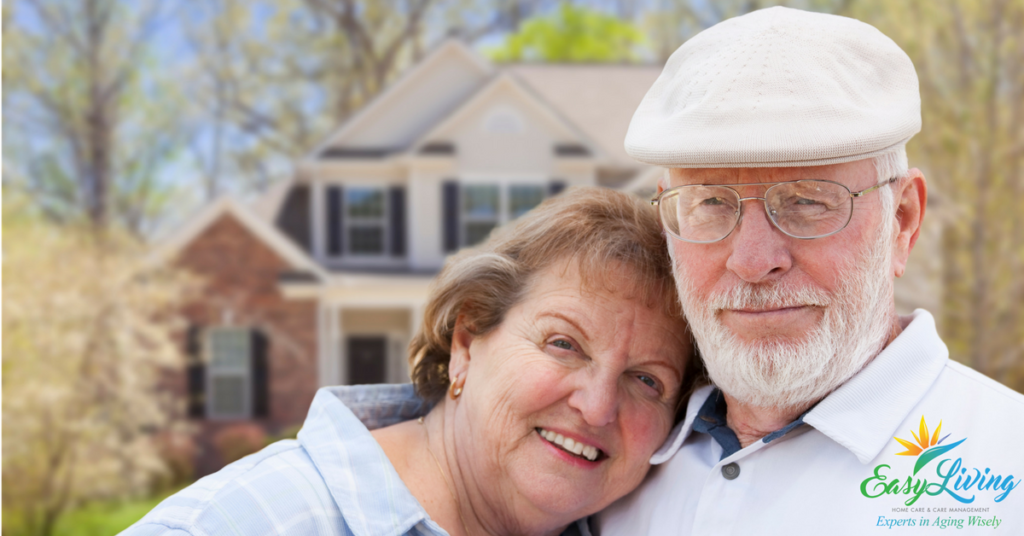Are you like 90+% of Americans, who wish to stay home as they get older? If you are, it’s vital to prepare your house to be age-friendly.
Falls are the leading cause of injury in older adults. Many times, these injuries derail plans for aging in place. A hospitalization leads to further issues and early ALF or nursing home placement. Fortunately, these falls and other in-home problems can be prevented. Today, we’ll take you on a virtual tour of your house. We’ll point out potential problems and solutions, so you can prepare your house for aging in place.
You can also Click Here to download our room-by-room aging in place checklist.
Talk to one of our aging-in-place experts about personalized solutions.
Aging in Place Checklist: Home Tour
Entry/Outside
Many of us have gotten a shoe snagged in the uneven pavement or tripped over some debris. When doing a home safety review, don’t forget the outside. Make sure the pathways are clear and accessible. Check to be sure there is sufficient lighting. Remove debris and excess shrubbery (important for crime safety too). Get uneven pavement fixed. Ideally, the entry should have a ramp or no stairs. This type of entry is friendly for strollers and all ages too!
Resources:
EasyLiving caregivers can help keep your entryway tidy. We can also recommend handymen to complete tasks like repairs and clearing overgrowth. When our care managers do a home assessment, they provide recommended solutions. For example, we might outline options and costs (and assistance programs) for getting a ramp installed.
Motion-activated lighting: check out several great options on Amazon, including eco-friendly solar-powered lights. You can also find plenty at your local Home Depot or hardware store.
Kitchen
One of the most common issues in the kitchen is having items out-of-reach. You may fall off of a step stool or injure yourself reaching or bending down. Plus, it’s not practical for comfortable daily living. Wet surfaces and loose rugs can create fall hazards. Some elders may have difficulty preparing meals. Using the stove or other equipment may become dangerous.
Resources:
Having a well-organized kitchen creates a safe, comfortable place to prepare meals. For example, our care manager did a full assessment for a client. She was eating poorly, pulling the couple items she could reach out of the freezer. She had a lot of spoiled food that she didn’t even know was there. She couldn’t reach some of the pans she needed to cook. A simple reorganization and cleaning out made all the difference.
Check out our delicious nutrition solutions for meal delivery services and more.
Toss those loose throw rugs and get a non-slip kitchen mat. Here’s one in many patterns. Or, get an anti-fatigue ergonomic mat for standing comfortably (may not be appropriate in all cases).
Living Space
Clutter, blocked pathways and poor lighting make a living area into a “death trap”. So many elders we know end up in the ER from falling over a cord or slipping on a rug. Getting up from chairs can be problematic too. The elder should demonstrate getting up from the chair and how they move about to pinpoint potential issues. They may need a different chair or lift chair/cushion, if appropriate.
Solutions:
Many elders have sentimental attachments to their throw rugs. One option is to secure the rug with double-sided tape or non-skid backing. An even safer option, for prized pieces, is to make the rug into a wall hanging.
There are many items like this to help with getting out of a chair. Get a professional aging-in-place assessment to understand what is safest for you. Our caregivers are trained in safe transfer techniques to help you get out of the car, chair, bed, etc.
Bedroom
Clutter may again be a problem here. But, two big issues are getting out of bed and going to the bathroom at night. Make sure there’s adequate lighting and a clear path.
Aging in Place Solutions:
Cheap nightlights work great. But, for clients who don’t like them, motion-activated lights work well. Lighting technology continues to evolve, so there’s no reason to feel your way in the dark. Check out the fun options like these motion-activated toilet seat lights!
Every elder should have a personal emergency response system. These became widely known through the “I’ve fallen and I can’t get up!” commercials. Unfortunately, that’s a reality we’ve seen too many times. Or, in the case of my grandmother, “I got into the tub and can’t get out”. These systems can be a lifesaver. We can recommend options for you, as well as more sophisticated home monitoring technologies.
Bathroom
Wet floors, slippery surfaces, stepping in and out of the wet tub, getting up from the low toilet…bathroom hazards abound. Any aging in place checklist will put heavy emphasis on the bathroom. It is one of the most common sites of falls and other accidents.
Solutions:
It’s easy to make the bathroom safe for aging in place. Simple, inexpensive fixes include grab bars, raised toilet seats, and shower chairs. Prevent slipping with non-slip bathmats and various options for the tub/shower surface. Or, the bathroom can be remodeled for a complete aging in place overhaul.
Take action with an aging in place plan
This is just a brief tour to show some of the key home safety hazards. Your aging in place checklist should include key issues like medication management, handling personal hygiene and daily tasks.
Get help:
Don’t let a lack of planning derail your “golden years”. It’s easy to live comfortably and safely at home.







